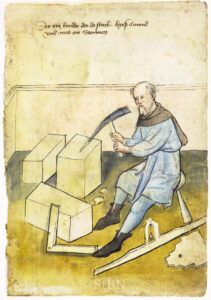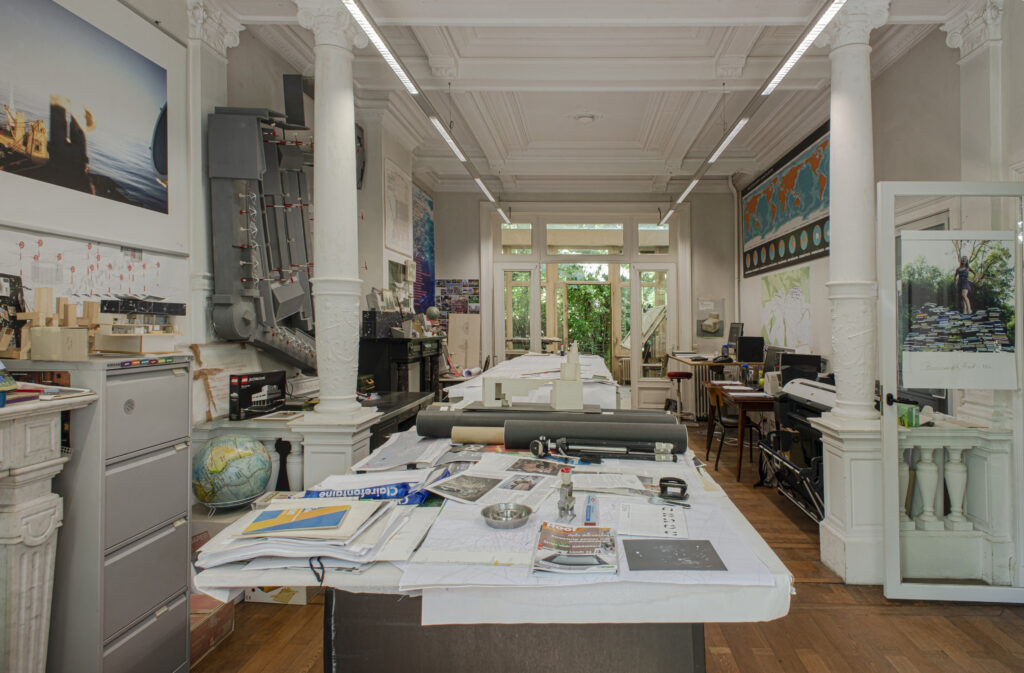Return to archive
title
Knowledge in Architecture: draughtsmanship or craftsmanship?
author
Eric Crevels
Abstract
What are draughtsmanship and craftsmanship in architecture and what is their relation? This question represents, of course, what could be called two distinct fields of knowledge and communities of practice, architecture and craft, and can very generally describe how their specific knowledge take shape or, in other words, through what kind of practice it is manifested.

Image 01: Mason worker drawing
Date: 1425
Source: Hausbuch der Mendelschen Zwölfbrüderstiftung, Band 1. Nürnberg 1426–1549. Stadtbibliothek Nürnberg, Amb. 317.2°
What are draughtsmanship and craftsmanship in architecture and what is their relation? This question represents, of course, what could be called two distinct fields of knowledge and communities of practice, architecture and craft, and can very generally describe how their specific knowledge take shape or, in other words, through what kind of practice it is manifested.
Considering the two as communities of practice with a mutual (and similar) focus on the production of physical objects, that, however, extrapolate their material dimension and reproduce a cultural environment; these words (draught and craftsmanship) generally indicate the skillset, or system of knowledge, of the professionals in these fields. In architecture literature, however, they are often used interchangeably. This conclusion can be seen in Richard Sennett’s famous the Craftsman 1 Richard, The Craftsman. , in Architecture as Craft, edited by Michiel Riedijk 2 Michiel, Architecture As A Craft. , and many others 3 Schukken, “Craft & Architecture: The Redefinition and Relevance of Craft in Contemporary Production.” .
However, should we equate draughtsmanship with craftsmanship so easily in architecture, considering Sennett’s advocacy for the reunion of the mind and the hand? Many authors, like Juhani Pallasmaa 4 Pallasmaa, Eyes of the Skin: Architecture and the Senses. , call for this reunion of the architect’s hand and mind, but, still, these appeals are limited to the sphere of design, and don’t encompass the hand in the laying of bricks, in the shaping of wood, carrying materials etc. Architectural history, on the other hand, is one of radical separation between the body and mind, when we consider the entirety of the construction process. Figures like Alberti and Brunelleschi, renowned as the precursors of the modern architect, actively advocated for this division, and, despite many attempts to reconnect them afterwards, the idea of design occupying the central position of the architect’s practice remained 5 Crevels, “The Tangible Presence of Human Labor in Architecture”; Ferro, Arquitetura e Trabalho Livre. .
Sketching and modelling, as methods in the development of design, are usually accepted and fostered as efficient and ever-lasting processes that do not only help but are often in the very core of the construction of ideas and navigation through the many tributaries of design 6 Perez-Gomez, “Architecture as Drawing”; Ingold, Making Anthropology, Archaeology, Art and Architecture; Dr Graaf, Four Walls and a Roof: The Complex Nature of a Simple Profession. . They are ways of both creating and controlling the creation, of seeing and exploring what is designed, establishing feedback loops in which, seemly, the object informs the architect about its own design – inverting the roles between creator and creation. By doing so, architects express ideas and values, design spaces according to the needs of clients and communities, and compose materials and techniques to raise buildings and structures. Draughtsmanship, then, can be considered the skillset that allows the architect to imprint knowledge of any of these dimensions (symbolic, functional and material) in a particular medium, a representation (be it a sketch, a technical drawing or a model).
Since it is through it that the architect relates to the other agents and elements of the object of his practice, draughtsmanship may well represent, therefore, the craftsmanship in the architect’s craft. However, architecture cannot simply be reduced to the practice of the architect. Ultimately, the question behind this duality is if architecture is only about making things possible, or about creating this potential and its materialization. In other words, if architecture is only about design or design and construction. On the one hand, if it is the former, we have to consider the lack of self-realization that architecture is bound to have, meaning that it can only be realized (or actualized, in Hegelian terms) outside its scope. The term architecture itself would have to refer solely to the abstract dimensions of design and lose its hold upon the material built environment. If not suicidal, this abandonment of its empirical object of study seems destructive to architecture as a practice beyond a field of knowledge.
Theodor Adorno, in his Negative Dialectics
7
Adorno, Dialéctica Negativa.
, warns us of the irreconcilable gap between the concept and the thing itself. Similarly, if we consider architecture as a whole, the craft of architecture – not of the architect – cannot be reduced to drawing, sketching or modelling. Drawings are not inhabited nor in any way address the same needs buildings do. They offer a possibility but don’t realize it in concrete reality. As influential as they may be, and as valuable embodiments of knowledge, they represent one part of the overall endeavour of making architecture. One that, as shown in Architecture Without Architects, by Bernard Rudofky, is not entirely necessary for its production
8
Rudofsky, Architecture Without Architects: A Short Introduction to Non-Pedigreed Architecture.
.
A parallel can be traced with music. A musical score is a tool for the composer to communicate and direct the musicians, and might as well be central in his process of creating a new song. However, it can’t be considered to embody the art of music as a whole. Music only becomes music when performed, be it live, recorded or through digital means, and that requires more than the knowledge to write it.
On the other hand, if architecture is the concerned with conceiving and producing, then craftsmanship in architecture cannot be reduced to draughtsmanship but must include all the knowledge and skills in both design and construction. It would imply the recognition of the knowledge and skills that, similarly to drawing, sketching and modelling for the architect, allow builders to manoeuvre the diverse aspects of their craft, making possible their production and, by consequence, the material formation of architecture.
For this recognition to be truthful to itself, following the etymological nature of the term re-cognitio as “knowing again”, not only this particular skillset must be looked at new light, but the epistemological hierarchy between different skillsets in architecture must be revised. Attempting to know something anew without departing from the very structures that made it unknown is an exercise bound to repeat failure. This flattening is required to re-sensitize our analytical gaze towards other knowledge sets present in architecture and the rationality behind them – the epistemes, to use a Foucauldian term 9 Foucault, The Archaeology of Knowledge. .
The question thus becomes one embedded in political consequence, If not immediately, in practice, given the social challenges of such endeavour, at least theoretically, for it requires a shift in our analytical episteme as well. It ultimately reaches the understanding of architecture as a whole, and the above-mentioned division between the craft of architectural design or that of architecture, or, to follow Lina Bo Bardi’s terminology, Architecture and architecture 10 Bardi, “Arquitetura Ou Arquitetura.” . How can we explain the primacy of design in the constitution of a field of knowledge, taught in Universities around the globe and advertized with prestige within the cultural industry, when accepting a flattening of the socioeconomic and symbolic distinctions between draughtsmanship and craftsmanship? Should we resign to Leonardo Benevolo’s definition of architecture as the “art of construction” to uphold a distinctive schism between design and construction 11 Benevolo, A História Da Cidade. , knowing well enough that this statement is self-destructive and that, by doing as much, we refuse to re-cognize knowledge that is essential to the making of the architecture itself?

Image 02: Sketch of a detail by John Ruskin
Source: http://www.themorgan.org/collection/literary-and-historical-manuscripts/191761
References
- Adorno, T. W. Dialéctica Negativa. Madrid, España: Taurus. Madrid: Taurus Ediciones S.A., 1984.
- Bardi, Lina Bo. “Arquitetura Ou Arquitetura.” Cronicas de Arte, de História, de Costume, de Cultura Da Vida. Arquitetura Pintura. Escultura. Música. Artes Visuais. September 21, 1958.
- Benevolo, Leonardo. A História Da Cidade. Historia Da Cidade. 3rd ed. Rome: Gius Laterza & Figli, 1997.
- Crevels, Eric. “The Tangible Presence of Human Labor in Architecture.” In Ambiances, Alloaesthesia: Senses, Inventions, Worlds. Proceedings of the 4th International Congress on Ambiances., edited by Damien Masson, 184–89. E-conference, 2-4 December 2020, 2 vol: Réseau International Ambiances, 2020.
- Dr Graaf, Reinier. Four Walls and a Roof: The Complex Nature of a Simple Profession. Cambridge: Harvard University Press, 2017.
- Ferro, Sergio. Arquitetura e Trabalho Livre. São Paulo: Cosac Naify, 2006.
- Foucault, Michel. The Archaeology of Knowledge. New York: Vintage Books, 2010.
- Ingold, Tim. Making Anthropology, Archaeology, Art and Architecture. Making Anthropology, Archaeology, Art and Architecture, 2013. https://doi.org/10.4324/9780203559055.
- Michiel, Riedijk. Architecture As A Craft. Edited by Riedijk Michiel. Amsterdam: Martien de Vletter, 2011.
- Pallasmaa, Juhani. Eyes of the Skin: Architecture and the Senses. Architect. Vol. 95. Chichester: John Wiley and Sons Ltd, 2006.
- Perez-Gomez, Alberto. “Architecture as Drawing.” Journal of Architectural Education 36, no. 2 (1982): 2–7. https://doi.org/10.1080/10464883.1982.10758306.
- Richard, Sennett. The Craftsman. London: Yale University Press, 2008.
- Rudofsky, Bernard. Architecture Without Architects: A Short Introduction to Non-Pedigreed Architecture. New York: Doubleday & Co. Inc, 1964.
- Schukken, Aukje. “Craft & Architecture: The Redefinition and Relevance of Craft in Contemporary Production.” Delft University of Technology, 2016.
- Richard, The Craftsman.
- Michiel, Architecture As A Craft.
- Schukken, “Craft & Architecture: The Redefinition and Relevance of Craft in Contemporary Production.”
- Pallasmaa, Eyes of the Skin: Architecture and the Senses.
- Crevels, “The Tangible Presence of Human Labor in Architecture”; Ferro, Arquitetura e Trabalho Livre.
- Perez-Gomez, “Architecture as Drawing”; Ingold, Making Anthropology, Archaeology, Art and Architecture; Dr Graaf, Four Walls and a Roof: The Complex Nature of a Simple Profession.
- Adorno, Dialéctica Negativa.
- Rudofsky, Architecture Without Architects: A Short Introduction to Non-Pedigreed Architecture.
- Foucault, The Archaeology of Knowledge.
- Bardi, “Arquitetura Ou Arquitetura.”
- Benevolo, A História Da Cidade.



